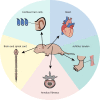The regenerative capacity of neonatal tissues
- PMID: 35708609
- PMCID: PMC9270969
- DOI: 10.1242/dev.199819
The regenerative capacity of neonatal tissues
Abstract
It is well established that humans and other mammals are minimally regenerative compared with organisms such as zebrafish, salamander or amphibians. In recent years, however, the identification of regenerative potential in neonatal mouse tissues that normally heal poorly in adults has transformed our understanding of regenerative capacity in mammals. In this Review, we survey the mammalian tissues for which regenerative or improved neonatal healing has been established, including the heart, cochlear hair cells, the brain and spinal cord, and dense connective tissues. We also highlight common and/or tissue-specific mechanisms of neonatal regeneration, which involve cells, signaling pathways, extracellular matrix, immune cells and other factors. The identification of such common features across neonatal tissues may direct therapeutic strategies that will be broadly applicable to multiple adult tissues.
Keywords: Mouse regeneration; Neonatal healing; Neonatal regeneration.
© 2022. Published by The Company of Biologists Ltd.
Conflict of interest statement
Competing interests The authors declare no competing or financial interests.
Figures




Similar articles
-
Blueprints for healing: central nervous system regeneration in zebrafish and neonatal mice.BMC Biol. 2025 Apr 30;23(1):115. doi: 10.1186/s12915-025-02203-0. BMC Biol. 2025. PMID: 40307837 Free PMC article. Review.
-
Turning back the cardiac regenerative clock: lessons from the neonate.Trends Cardiovasc Med. 2012 Jul;22(5):128-33. doi: 10.1016/j.tcm.2012.07.008. Epub 2012 Aug 14. Trends Cardiovasc Med. 2012. PMID: 22902092 Review.
-
The promise of perfect adult tissue repair and regeneration in mammals: Learning from regenerative amphibians and fish.Bioessays. 2014 Sep;36(9):861-71. doi: 10.1002/bies.201300144. Epub 2014 Jul 9. Bioessays. 2014. PMID: 25043537 Review.
-
A Roadmap to Heart Regeneration Through Conserved Mechanisms in Zebrafish and Mammals.Curr Cardiol Rep. 2021 Mar 2;23(4):29. doi: 10.1007/s11886-021-01459-6. Curr Cardiol Rep. 2021. PMID: 33655359 Free PMC article. Review.
-
How can the adult zebrafish and neonatal mice teach us about stimulating cardiac regeneration in the human heart?Regen Med. 2023 Jan;18(1):85-99. doi: 10.2217/rme-2022-0161. Epub 2022 Nov 23. Regen Med. 2023. PMID: 36416596 Review.
Cited by
-
Enduring questions in regenerative biology and the search for answers.Commun Biol. 2023 Nov 9;6(1):1139. doi: 10.1038/s42003-023-05505-7. Commun Biol. 2023. PMID: 37945686 Free PMC article. Review.
-
PI3K-Akt signalling regulates Scx-lineage tenocytes and Tppp3-lineage paratenon sheath cells in neonatal tendon regeneration.Nat Commun. 2025 Apr 20;16(1):3734. doi: 10.1038/s41467-025-59010-y. Nat Commun. 2025. PMID: 40254618 Free PMC article.
-
Suppressing DBNDD2 promotes neuron growth and axon regeneration in adult mammals.Front Med. 2025 Aug;19(4):636-652. doi: 10.1007/s11684-025-1146-2. Epub 2025 Jul 14. Front Med. 2025. PMID: 40658351
-
Blueprints for healing: central nervous system regeneration in zebrafish and neonatal mice.BMC Biol. 2025 Apr 30;23(1):115. doi: 10.1186/s12915-025-02203-0. BMC Biol. 2025. PMID: 40307837 Free PMC article. Review.
References
-
- Aguirre, A., Montserrat, N., Zacchigna, S., Nivet, E., Hishida, T., Krause, M. N., Kurian, L., Ocampo, A., Vazquez-Ferrer, E., Rodriguez-Esteban, C.et al. (2014). In vivo activation of a conserved MicroRNA program induces mammalian heart regeneration. Cell Stem Cell 15, 589-604. 10.1016/j.stem.2014.10.003 - DOI - PMC - PubMed
-
- Arvind, V., Howell, K. and Huang, A. H. (2021). Reprogramming adult tendon healing using regenerative neonatal regulatory T cells. biorXiv. 10.1101/2021.05.12.443424 - DOI
Publication types
MeSH terms
Grants and funding
LinkOut - more resources
Full Text Sources

